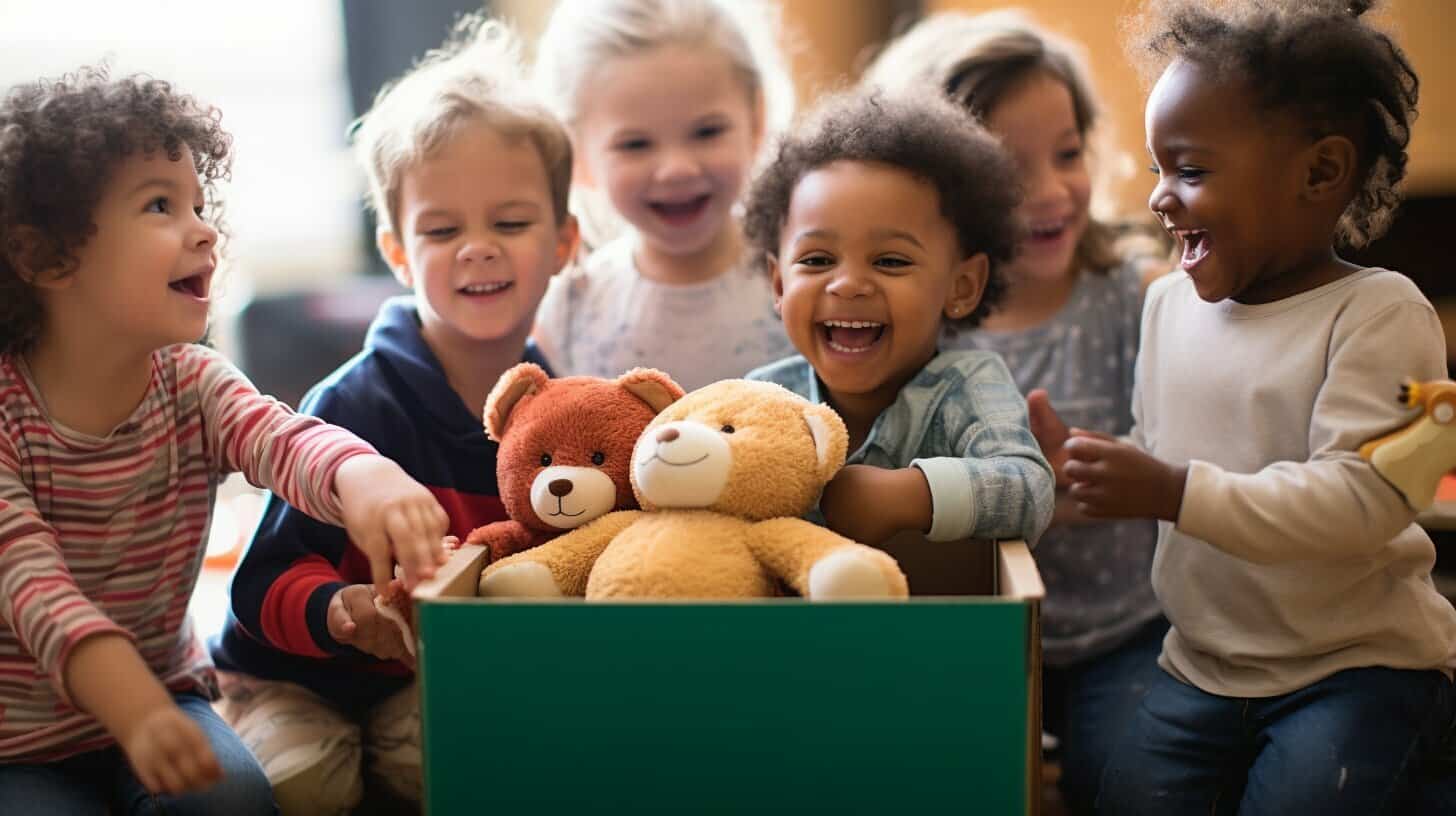As parents, Teaching Giving To Children is on the top of our list. One of the best ways to instill these values in children is by teaching them about giving. Teaching children the importance of giving can help them develop a sense of responsibility towards others and improve their social skills.
But why is teaching giving important for children? In the following sections, we’ll explore the benefits of teaching children about generosity and give you practical tips on how to instill a giving mindset in your kids.
Why is Teaching Giving Important for Children?
Teaching children about giving and generosity is crucial for their overall development. It helps them to understand their role in society and cultivates a sense of empathy and kindness towards others.
By promoting giving in children, we can instill a sense of responsibility and encourage them to consider how their actions affect those around them. It also improves their social skills by giving them the opportunity to interact with individuals from different backgrounds and learn to appreciate diversity.
Why is Teaching Giving Important for Children?
Teaching generosity to kids is important because it helps them understand that they have the power to make a positive impact on the world, no matter how big or small. It also allows them to develop a sense of gratitude for what they have and appreciate the value of giving back to others.

Instilling Philanthropy in Children
There are many ways to foster a giving mindset in children. One of the most effective approaches is to introduce philanthropy to them. Philanthropy is the act of donating time, money or talent to a charitable cause. Instilling philanthropy in kids can help them understand the importance of giving back and making a difference in the world.
Here are some ways to introduce philanthropy to your children:
| Activities | Description |
|---|---|
| Donate to Charity | Encourage your child to donate a portion of their allowance or money they have earned to a charity they care about. Show them how their contribution can make a difference, and help them research and choose a charity that they are passionate about. |
| Organize Family Volunteer Activities | Volunteering as a family can help children see the impact of their contributions and build empathy for those in need. Consider volunteering at a local soup kitchen, animal shelter, or community garden. |
| Discuss the Impact of Giving | Have conversations with your child about the positive impact of giving and helping others. Discuss how different types of charitable gifts (money, time, or talent) can benefit different people and organizations. |
By introducing philanthropy to your children and teaching them about the importance of giving, you can help them develop a lifelong interest in making a positive difference in the world.

Teaching Children About Giving Back
One key aspect of instilling generosity in children is teaching them about the importance of giving back to their communities. Encouraging children to participate in community projects, volunteer activities, and other social causes can help them develop a sense of civic responsibility and empathy towards others.
One way to get kids involved in giving back is to find projects that align with their interests or passions. For example, if your child loves animals, consider volunteering at a local animal shelter or fundraising for a wildlife conservation organization. This approach can also be helpful in combating resistance from children who may not be initially enthusiastic about giving back.
Another effective way to promote a giving mindset in children is to model generosity in your daily life. Show your children through your actions that giving back is important and fulfilling, and explain how even small acts of kindness can make a difference in someone’s life. You can also talk with your child about how giving back benefits the community as a whole, rather than just one individual.
Remember that giving back doesn’t always need to involve monetary donations. Encourage your child to consider other forms of giving, such as donating time, talent, or skills. This can include activities like baking cookies for a neighbor, mowing an elderly neighbor’s lawn, or making cards for healthcare workers.
Teaching children about giving back can also help them develop important life skills, such as teamwork, problem-solving, and communication. By working together on a community project, children can learn how to collaborate with others towards a common goal, while also gaining confidence in their abilities.
The Role of Charity in Teaching Kids about Giving
Charity plays a crucial role in teaching kids about giving. It allows children to see the impact of their donations and the difference they can make in another person’s life. It’s important to introduce kids to charity work from an early age, so they can develop a sense of empathy and social responsibility.
There are many ways to introduce kids to charity work. Start by discussing different types of charities and the causes they support. You can also research charities together and choose one that resonates with your child.
Once you’ve chosen a charity, encourage your child to get involved. This can include volunteering time or organizing a fundraising event to support the charity. It’s important to help your child understand the impact that their efforts can have and to celebrate their successes.
Charity work can also be a great way to bond as a family. Consider making charity work a regular family activity and involve your child in the decision-making process. This will give them a sense of ownership and help them develop skills like leadership and teamwork.
Overall, introducing kids to charity work can have a profound impact on their sense of social responsibility and their understanding of the impact that giving can have in the world. By teaching kids about charity, we can help them develop a lifelong commitment to giving and making a difference in the world.
Making Giving a Family Affair
Teaching kids about giving is a family affair. It takes the cooperation of parents, grandparents, and other family members to instill the value of generosity in children. Here are practical ways to involve the whole family in teaching kids about giving:
- Set up family giving goals: Involve your family in setting up giving goals. Encourage each member to choose a charitable cause or organization that they care about. Set a target for the amount of money or time that your family wants to donate to these causes.
- Create giving traditions: Establishing giving traditions can make giving a fun and meaningful experience for kids. For example, make it a habit to donate to a charity during the holiday season or participate in a charity walk with your family every year.
- Model generosity in everyday life: Children learn by example. Make sure that you model generosity in everyday life by volunteering your time, giving to charity, and helping others whenever possible.
- Encourage kids to give to others: Teach kids to be generous by encouraging them to give to others. This can be as simple as helping a neighbor with yard work or giving a portion of their allowance to a charitable cause.
- Discuss giving values as a family: Discussing giving values as a family can help develop empathy and understanding in children. Talk to your kids about why giving is important and how it can make a difference in the world.
Teaching kids about giving is more than just writing a check to a charity. It’s about instilling values that will stay with your child for a lifetime. By involving the whole family in this process, you can make giving a fun, meaningful, and rewarding experience for everyone.
Making Giving a Family Affair
Teaching children about giving is not a one-time event, but rather an ongoing process that requires a family effort. By involving the whole family, you can create a giving culture that promotes empathy, kindness, and social responsibility.
Here are some practical tips for making giving a family affair:
| Tip | Description |
|---|---|
| Set family giving goals | Discuss as a family what causes or charities you want to support and set a giving target for the year. This will give your family a sense of purpose and direction when it comes to giving. |
| Create giving traditions | Establish a tradition that involves giving back, such as volunteering at a local charity or donating a portion of birthday money to a cause. This will help reinforce the value of giving in your family’s culture. |
| Model generosity in everyday life | Children learn by example, so it’s important to demonstrate generosity in your daily life. This can be as simple as helping a neighbor with their groceries or donating clothes to a shelter. |
Remember, giving is not just about money, it’s about making a positive impact in the world. By involving your whole family in the giving process, you can create a culture of kindness and generosity that will benefit your children for years to come.

Teaching Kids About Different Forms of Giving
Teaching kids about giving goes beyond simply writing a check to a charity. It’s important to show them that there are different forms of giving, including time, talent, treasure, and touch.
Time: Encourage your child to volunteer their time by participating in community service projects, visiting an elderly neighbor, or helping out at a local shelter.
Talent: Help your child understand that they have unique talents that can be used for good. Encourage them to use their talents to help others, such as teaching a skill to a friend or creating a piece of art to donate to a charity auction.
Treasure: Teaching kids about financial giving can be as simple as setting aside a portion of their allowance to donate to a cause they care about. Additionally, you can encourage kids to make charitable donations instead of receiving gifts for holidays or birthdays.
Touch: Physical touch, such as a hug or a smile, can also be a form of giving. Encourage your child to show kindness and compassion to those around them.
By introducing kids to the different forms of giving, they’ll begin to understand that generosity is not limited to monetary donations. It’s important to help kids find giving opportunities that align with their interests and strengths, as this will incentivize them to continue giving throughout their lives.
Cultivating a Giving Mindset in Children
Teaching children about giving is more than just donating money. It’s about instilling a mindset of generosity and kindness that will last a lifetime. Here are some practical tips for cultivating a giving mindset in children:
- Start small: Encourage your child to perform small acts of kindness, such as holding the door open for someone or sharing a toy with a friend. Celebrate these actions and show your child how their actions can brighten someone’s day.
- Celebrate acts of kindness: When your child does something kind, celebrate it! Praise them for their action and talk about how it made the other person feel.
- Use positive language: Use positive language when talking about giving and generosity. Instead of saying “don’t be selfish,” say “let’s think about how we can help others.”
- Empower your child: Encourage your child to come up with their own ideas for giving and act on them. Let them choose the cause they want to support and involve them in the process.
By following these tips, you can help your child develop a giving mindset that will benefit them and those around them for years to come.
Teaching Giving To Children – FAQ
Teaching kids about giving is an important aspect of nurturing generosity and kindness. However, you may have some questions about how to start or how to handle any resistance from your children. Here are some frequently asked questions and their answers:
When is the right time to start teaching giving to children?
It is never too early to start teaching kids about giving. Even toddlers can learn about sharing and giving. As kids grow older, you can introduce more complex concepts and activities that promote giving.
How can I handle resistance from my child when it comes to giving?
It is common for children to resist giving, especially if they are not used to it. You can start small and make giving a fun and positive experience. For example, encourage your child to donate a toy they no longer play with, or bake cookies for a neighbor. Praise their efforts and celebrate their kindness.
How can I ensure that giving is a positive experience for my child?
Make giving a family affair and involve your child in the decision-making process. Let them choose the cause or charity they want to support. Celebrate their acts of kindness and encourage them to make a positive impact on the world. Keep the focus on the joy and satisfaction that comes from giving, rather than the obligation to do so.
How can I help my child understand the impact of their giving?
Show your child how their giving can make a difference. For example, if they donate money to a charity that helps animals, take them to a shelter to see how the money is being used. Or, if they volunteer at a food bank, explain how their actions help those in need. Help them understand that even small acts of kindness can have a big impact.
How can I make giving a regular part of my child’s life?
Make giving a habit by setting up regular giving goals as a family. For example, you could commit to volunteering at a local charity once a month or donating a portion of your allowance to a specific cause. Create traditions around giving, such as making care packages for those in need during the holidays or cleaning up a local park together. By making giving a regular part of your child’s life, you reinforce the importance of generosity and kindness.





Leave a Reply